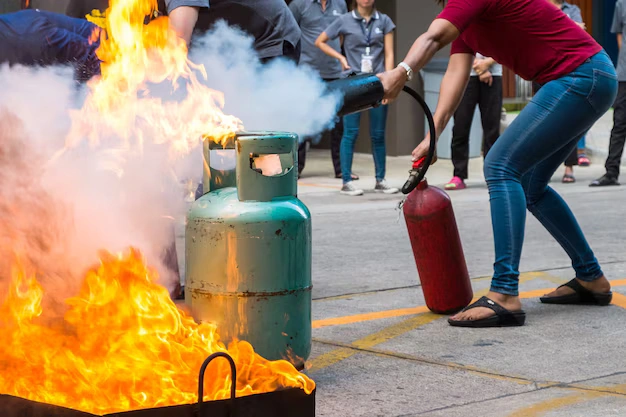Thousands of workplace fires each year cause injuries together with human deaths and millions of dollars in property damage. The National Fire Protection Association (NFPA) reports $2.6 billion worth of property losses from non-residential building fires during the year 220 in the U.S. The United Arab Emirates recognizes both construction and manufacturing as well as hospitality as its most prominent fire hazard industries. Any workplace should have employees who know the right steps for a correct response during emergencies because incidents can happen at any time; therefore, fire safety training remains the backbone of workplace safety programs designed to minimize risks.

The training provides workers with knowledge to identify fire hazards and shows them prevention methods alongside their response strategies in emergency fire situations. The combination of fire accident prevention and safety standard and local regulation compliance achieves a safe work environment with maximum operational efficiency.
Workplace entities need fire safety training because it serves essential functions.
Why Fire Safety Training Is Essential
1. Preventing Fires
The main purpose of fire safety training consists of instructing employees about appropriate measures to avoid all fire incidents. Your understanding of ordinary workplace fire risks, including bad wiring diagnostics, overloaded power circuits and unsafe storage of flammable materials, enables you to minimize these hazards. Preventive measures bring greater long-term cost savings since they cost less than managing the consequences after fires occur. The ability of properly trained employees enables them to detect potential risks, which they can report before threats materialize.
2. Understanding Fire Safety Equipment
Fire safety training requires employees to learn correct procedures for using all available safety devices. Public safety devices consist of fire safety instruments, which include fire extinguishers together with alarms, smoke detectors and fire blankets as part of the system. All employees need to understand which specific fire extinguisher works best for particular fires, and they require training about proper extinguisher handling as well as emergency response to fire alarms. Taking measures with fire safety equipment during emergencies makes all the difference in terms of second-by-second response because each moment counts when fighting fire hazards that develop into fatal situations rapidly.
3. Evacuation Procedures
A clear evacuation plan is vital in saving lives in the event of a fire emergency. Fire safety training also includes how to evacuate the building quickly and efficiently. These encompass familiarizing them with exit routes, assembly points and protocols to account for all personnel. Practice evacuating the building regularly and ensure all employees know how to exit the building calmly and without panic, avoiding bottlenecks that can slow down the process.
4. Reducing Panic
Panic usually ensues when a fire breaks, causing more danger. Training employees on how to deal with a fire will help them remain calm and make an informed decision. By training regularly and knowing what to do, employees can respond quickly and effectively in case of a fire. Doing so reduces the chances of chaos and uncertainty, protecting all employees in the facility.
5. Creating a Safety Culture
This helps develop a safety-centric culture in the workplace. Knowing the common igniters will adhere employees to follow safety measures, which makes the working environment much safer. Fire safety training also teaches employees to be aware of not only fire hazards but other hazards in the workplace. In such environments where employees are constantly being trained about safety measures in place, the workplace will have little to no accidents overall.
6. Legal Compliance
Fire Alarm System Installation According to the UAE, fire protection & fire alarm is a mandatory requirement for businesses in the UAE by law and in accordance with UAE Civil Defense Fire Safety Standards. This means employees must be trained on fire safety practices, for evacuations, for proper fire extinguisher use, etc. Non-compliance can lead to penalties, fines, and even cessation of business activities.
Key Elements of Effective Fire Safety Training
1. Fire Hazard Identification
Training should help workers learn to identify potential fire hazards in their workplace, from flammable materials to chemicals stored improperly to defective electrical wiring. And the first step to stopping a fire is knowing how to identify those hazards.
2. Properly Use Fire Extinguishers
When using fire extinguishers, employees should be trained on the proper procedures. Such as knowing what type of fire extinguisher to use on what type of fire (electrical, chemical, or paper), as well as how to use it.
3. Evacuation Routes and Procedures
It should consist of all fire exits, escape routes and assembly points. Workers should know how to evacuate the building in a regular way and where to meet once they’re safely outside. Regular drills for evacuating the building drive home this training.

4. Fire Safety Equipment Maintenance
Employees should know what fire safety equipment is available and how to keep it functional.
5. Responding to Emergencies
Fire safety training needs to explain what to do in a fire emergency. Additional guidance covers how to alert others, where to find the nearest fire exits, and how to assist others, particularly those with special needs or disabilities, during emergency evacuation.
6. Industry-Specific Fire Safety
There are specific fire safety risks for certain sectors. Construction sites often have flammable building materials, and restaurants with kitchens are subject to grease fires. Fire safety training should be customized based on the unique risks posed by a given industry or workplace.
Benefits of Fire Safety Training for Businesses
1. Reduced Risk of Fires
Fire safety training minimizes the chances of fire by teaching employees the hazards they will be subjected to and how to prevent them. If the employees know how to behave in case of a fire break-out, such an accident can be avoided to a great extent.
2. Improved Emergency Response
Training your employees in fire safety will ensure they understand exactly how to respond in the event of a fire, enabling a quick and effective response. A fast response can stop a smoldering fire before it spreads, reducing damage and saving lives.
3. Legal/Financial Protection
Compliance with Regulations: Businesses must comply with the local fire safety regulations. In the case of the UAE, failing to do so can lead the regulatory authorities to impose a fine or penalty. Compliance with fire safety regulations helps mitigate the risk of costly legal battles or disruptions for a business.
4. Enhanced Employee Confidence
When the employees are trained correctly for the fire safety aspects, they will feel safe and confident in the workplace. When employees feel safe (both physically and psychologically), morale improves, and they become more productive and engaged at work.

5. Lower Insurance Costs
For businesses with well-owned fire safety programs, regular fire safety training may qualify for lower insurance premiums. Taking proactive measures to eliminate risks works in your business favor since insurance brokers frequently incentivize such approaches by rewarding businesses that take the preventative route, hence saving costs in the long run.
6. Reduced Workplace Downtime
Businesses can save on workplace downtime by preventing fires and allowing quick and efficient evacuations. What this means is that things can keep running with little to no disruption, which makes for greater overall efficiency.
Q&A (Question and Answer)
Fire safety training should be part of a business’s regular safety training program and may include a review every 6 months, or at least once a year.
Fire safety must be trained every year, but refresher courses or additional training are required whenever the workplace hazards or fire safety regulations undergo significant changes. To maintain a level of readiness, regular drills are critical.
Who Provides Fire Safety Training?
It is the duty of the employers to train their stakeholders for fire safety. This is usually done by the company’s safety officer, fire marshal, or a certified fire safety trainer.
The Main Elements of a Fire Safety Training Program
The best fire safety training should include instruction on identifying fire hazards, how to use a fire extinguisher, evacuation procedures, service equipment maintenance, and preventive interventions according to specific industry demands.
Is there a legal requirement for fire safety training for employees in the UAE?
Yes, fire safety training is compulsory in UAE businesses as per the UAE Civil Defense rules. Otherwise, you might have to face legal consequences.
Is it completely out of the question that fire safety training could reduce workplace injuries?
Yes, fire safety training reduces workplace injuries by educating employees on preventing fires and what to do in the case of an emergency. A well-trained staff will have a reduced chance of injury if a fire occurs.
The Financial Benefits of Fire Safety Training for Businesses
They can lower insurance premiums, prevent expensive fines for violations, and reduce losses from property destruction or business interruption caused by fires with fire safety training. This is a cost-effective way to protect both employees and assets by investing in training.
Conclusion
This is the reason behind making fire safety training part of the workplace that will help in reducing fire hazards by providing all the necessary details on how to identify fire hazards, how to prevent the fire, how to use the fire safety equipment, and how to evacuate in case of fire, to name a few. Such training helps companies not only meet their legal obligations but also enhance workplace safety and reduce fire-related accidents, thus promoting a safety culture. Fire safety training protects everything from employees to property to the company’s reputation, creating a safer and more productive environment.


